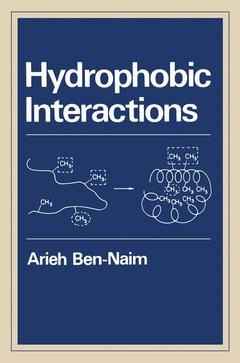Hydrophobic Interactions, Softcover reprint of the original 1st ed. 1980
Langue : Anglais
Auteur : Ben-Naim Arieh Y.

My personal involvement with the problem of hydrophobic interactions (HI) began about ten years ago. At that time I was asked to write a review article on the properties of aqueous solutions of nonpolar solutes. While surveying the literature on this subject I found numerous discussions of the concept of HI. My interest in these interactions increased especially after reading the now classical review of W. Kauzmann (1959), in which the importance of the HI to biochemical processes is stressed. Yet, in spite of having read quite extensively on the various aspects of the subject, I acquired only a very vague idea of what people actually had in mind when referring to HI. In fact, it became quite clear that the term HI was applied by different authors to describe and interpret quite different phenomena occurring in aqueous solutions. Thus, even the most fundamental question of the very definition of the concept of HI remained unanswered. But other questions followed, e. g. : Are HI really a well established experimental fact? Is there any relation between HI and the peculiar properties of water? Is the phenomenon really unique to aqueous solutions? Finally, perhaps the most crucial question I sought to answer was whether or not there exists hard evidence that HI are really important -as often claimed-in biological processes.
1. Introduction and Fundamental Equations.- 1.1. What Are Hydrophobic Interactions?.- 1.2. The Fundamental Expression for the Chemical Potential.- 1.3. Definition of Hydrophobic Interaction (HI).- 1.4. Probability Interpretation.- 1.5. Integrals Involving gss(R).- 2. Very Dilute Solutions and Hydrophobic Interaction.- 2.1. Introduction.- 2.2. Standard Free Energies of Transfer.- 2.3. Some Numerical Examples of ??tr° between Pure Phases.- 2.4. Some Numerical Examples of ??tr° between More Complex Phases.- 2.5. Survey of Theoretical Methods of Estimating ??tr°(G ? W).- 2.6. Some Words of Caution.- 3. Pairwise Hydrophobic Interaction (HI).- 3.1. Introduction.- 3.2. The Full Pair Correlation Function gss(R).- 3.3. Values of ?GHI at One Specific Distance.- 3.4. Effect of Variation of the Solvent on ?GHI(?1).- 3.5. Solute-Solute Affinity at Infinite Dilution.- 3.6. Solute-Solute Affinity at Finite Concentrations.- 3.7. Dimerization Equilibrium.- 3.8. Ion-Pair Formation by Double Long-Chain Electrolytes.- 3.9. Kinetics of Aminolysis by Long-Chain Alkylamines of Some Long-Chain Esters of p-Nitrophenol.- 3.10. Application of NMR and ESR Techniques.- 4. Hydrophobic Interaction among Many Solute Particles.- 4.1. Introduction.- 4.2. A Specific Example for Demonstrating the Nonadditivity Effect.- 4.3. The Relation between HI and the Standard Free Energy of Aggregation.- 4.4. Approximate Measure of the HI among m Solute Particles.- 4.5. An Improved Approximate Measure of the HI.- 4.6. Application of the Scaled-Particle Theory (SPT).- 4.7. A Direct Measure of Intramolecular HI.- 4.8. HI in Aqueous Micellar Solutions.- 4.9. HI in Synthetic and Biological Polymers.- 5. Temperature and Pressure Dependence of the Hydrophobic Interactions.- 5.1. Introduction.- 5.2. Temperature and Pressure Derivatives of the Standard Free Energy of Transfer.- 5.3. Temperature and Pressure Derivatives of the HI.- 5.4. Experimental Observations on the Temperature Dependence of the HI.- 5.5. Experimental Information on the Pressure Dependence of the HI.- 5.6. Formal Statistical Mechanical Expressions for the Entropy, Enthalpy, and Volume Changes Associated with the HI.- 5.7. Definition of the Structure of Water (SOW).- 5.8. How Much Structural Change in the Solvent?.- 5.9. Effect of Structural Changes in the Solvent (SCIS) on the Thermodynamics of Solubility and HI.- 5.10. A Simple Solvable Model.- Appendixes.- A.1. The Fundamental Equation for the Chemical Potential in a Two-Component System.- A.2. Conditional Standard Free Energy of Transfer.- A.3. Dimerization Free Energy of Molecules of the Type R-Y.- A.4. Rudiments of the Scaled-Particle Theory (SPT).- A.5. Conformational Change of a Biopolymer and Standard Free Energy of Transfer.- A.7. Standard Free Energy of Solution of Solute Molecules Having Internal Rotations.- A.8. On the Solvent Contribution to the Standard Free Energy of Micelle Formation.- A.9. Standard Free Energy of Transferring a Solute from the Solvent into a Micelle.- References.
Date de parution : 03-2012
Ouvrage de 320 p.
15.2x22.9 cm
Disponible chez l'éditeur (délai d'approvisionnement : 15 jours).
Prix indicatif 52,74 €
Ajouter au panierThème de Hydrophobic Interactions :
Mots-clés :
NMR; biological; electrolyte; enthalpy; entropy; experiment; kinetics; phenol; structure; thermodynamics; water
© 2024 LAVOISIER S.A.S.


